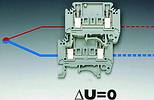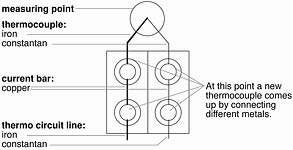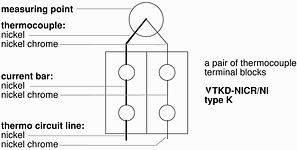
Where exact measurements are crucial to process engineering and laboratory technology, the installation of the measuring circuit can be as important as the selection of the measurement instrument. For sensitive measurement technology, accuracy and reliability are of fundamental importance.
In these sectors temperature measurements are often taken using thermocouples. These are low-cost and robust and are notable for their tight measurement tolerances.
In a process environment often several measurement points have to be monitored in parallel, whether in the case of analog evaluations or because the temperature difference between two points is of importance for a particular procedure. These readings, which have to be obtained from differing locations, often with very difficult access, come together at a central measuring station, where they are evaluated. Between the measurement point and the measuring device there has to be a constant and absolutely trouble-free connection, in order to avoid the possibility of measurement errors.

How does a thermocouple work?
A thermocouple simply consists of two wires made of different metals, for example copper and constantan (Figure 1). These are joined at the end (either twisted together or welded) and are run to the measuring device insulated from each other.

Under the effects of heat on the twisted or soldered connection point a direct voltage (thermoelectric voltage) is created between the two metals, which can be measured and provides an indication of the temperature (Figure 2). Thermocouples are used in measurement ranges between -200 and +1600°C.

Different thermocouples are used for various temperature levels, since certain combinations of metals supply thermoelectric voltages of quite different characteristics. There are many different variants of thermocouples: for example the combination nickel-chromium/nickel is used for measurements from 0 to 1200°C, while in the range between -200 and +600°C the copper/constantan combination is preferable (Table 1 and Table 2).


For the measurement process the thermocouple is run to the location to be measured, and then the measuring device linked to the thermocouple evaluates the temperature readings. The transmission path of the thermocouples, in other words the distance between the measurement point and the measuring device, is limited by the design of the device. In order to deal with long distances it is necessary to lengthen the path by the use of a thermal compensation cable, with a modular terminal block being used as the connection element.

The 'special' connection
Thermoelectric voltage terminals from Phoenix Contact offer a stable connection between a thermocouple and its 'extension' (Figure 4). Commercially available modular terminal blocks cannot perform this function, as the conductive current bar or the current-bearing parts are made exclusively of copper. The meeting of the two differing metals at the connection points would create an undesired new thermocouple, giving an erroneous measurement result (Figure 3).

Unlike normal commercially available modular terminal blocks, because of the way they are constructed, thermoelectric voltage terminals are offered only in pairs. The current bars are a pair of terminal blocks consisting of different metals, which are individually matched to the materials of the thermocouple to be used. This means that the combinations of metals of the temperature-measuring components can be continuous, without any need for a break. Using this principle, all thermocouples can transmit their signals over relatively great distances, using suitable connection terminal blocks, without creating significant measurement errors.
Given the wide variety of combinations of metals, thermoelectric voltage terminals are available from Phoenix Contact for the following types:
* Copper/constantan, CU/CUNI, type T.
* Iron/constantan, FE/CUNI, type J.
* Nickel-chromium/nickel, NICR/NI, type K.
* Platinum-rhodium/platinum, Pt-Rh 10% Pt, type S.
* Nickel-chromium/constantan, NICR/CUNI, type E.
By setting up pairs of thermoelectric voltage terminals it is possible to take exact temperature measurements even over relatively great distances. All types of thermocouples can be fitted with suitable combinations of pairs of thermoelectric voltage terminals and thus wired up without difficulty.
| Tel: | +27 11 801 8200 |
| Email: | [email protected] |
| www: | www.phoenixcontact.co.za |
| Articles: | More information and articles about Phoenix Contact |

© Technews Publishing (Pty) Ltd | All Rights Reserved